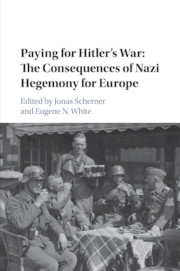Refine search
Actions for selected content:
26946 results in Economic history
List of tables
-
- Book:
- The Economic History of China
- Published online:
- 05 March 2016
- Print publication:
- 07 March 2016, pp xi-xii
-
- Chapter
- Export citation
Introduction
-
- Book:
- The Economic History of China
- Published online:
- 05 March 2016
- Print publication:
- 07 March 2016, pp 1-10
-
- Chapter
- Export citation
3 - Economic foundations of the universal empire (250 to 81 BCE)
-
- Book:
- The Economic History of China
- Published online:
- 05 March 2016
- Print publication:
- 07 March 2016, pp 84-128
-
- Chapter
- Export citation
Acknowledgments
-
- Book:
- The Economic History of China
- Published online:
- 05 March 2016
- Print publication:
- 07 March 2016, pp xiii-xiv
-
- Chapter
- Export citation
List of figures
-
- Book:
- The Economic History of China
- Published online:
- 05 March 2016
- Print publication:
- 07 March 2016, pp viii-viii
-
- Chapter
- Export citation
1 - The Bronze Age economy (1045 to 707 BCE)
-
- Book:
- The Economic History of China
- Published online:
- 05 March 2016
- Print publication:
- 07 March 2016, pp 11-43
-
- Chapter
- Export citation
8 - The maturation of the market economy (1550 to 1800)
-
- Book:
- The Economic History of China
- Published online:
- 05 March 2016
- Print publication:
- 07 March 2016, pp 295-347
-
- Chapter
- Export citation
2 - From city-state to autocratic monarchy (707 to 250 BCE)
-
- Book:
- The Economic History of China
- Published online:
- 05 March 2016
- Print publication:
- 07 March 2016, pp 44-83
-
- Chapter
- Export citation
7 - The heyday of the Jiangnan economy (1127 to 1550)
-
- Book:
- The Economic History of China
- Published online:
- 05 March 2016
- Print publication:
- 07 March 2016, pp 255-294
-
- Chapter
- Export citation
List of maps
-
- Book:
- The Economic History of China
- Published online:
- 05 March 2016
- Print publication:
- 07 March 2016, pp ix-x
-
- Chapter
- Export citation
6 - Economic transformation in the Tang-Song transition (755 to 1127)
-
- Book:
- The Economic History of China
- Published online:
- 05 March 2016
- Print publication:
- 07 March 2016, pp 208-254
-
- Chapter
- Export citation
Index
-
- Book:
- The Economic History of China
- Published online:
- 05 March 2016
- Print publication:
- 07 March 2016, pp 448-461
-
- Chapter
- Export citation
Contents
-
- Book:
- The Economic History of China
- Published online:
- 05 March 2016
- Print publication:
- 07 March 2016, pp vii-vii
-
- Chapter
- Export citation
Frontmatter
-
- Book:
- The Economic History of China
- Published online:
- 05 March 2016
- Print publication:
- 07 March 2016, pp i-iv
-
- Chapter
- Export citation
9 - Domestic crises and global challenges: restructuring the imperial economy (1800 to 1900)
-
- Book:
- The Economic History of China
- Published online:
- 05 March 2016
- Print publication:
- 07 March 2016, pp 348-399
-
- Chapter
- Export citation
4 - Magnate society and the estate economy (81 BCE to 485 CE)
-
- Book:
- The Economic History of China
- Published online:
- 05 March 2016
- Print publication:
- 07 March 2016, pp 129-167
-
- Chapter
- Export citation
Bibliography
-
- Book:
- The Economic History of China
- Published online:
- 05 March 2016
- Print publication:
- 07 March 2016, pp 400-447
-
- Chapter
- Export citation
Dedication
-
- Book:
- The Economic History of China
- Published online:
- 05 March 2016
- Print publication:
- 07 March 2016, pp v-vi
-
- Chapter
- Export citation
5 - The Chinese-nomad synthesis and the reunification of the empire (485 to 755)
-
- Book:
- The Economic History of China
- Published online:
- 05 March 2016
- Print publication:
- 07 March 2016, pp 168-207
-
- Chapter
- Export citation

Paying for Hitler's War
- The Consequences of Nazi Hegemony for Europe
-
- Published online:
- 05 March 2016
- Print publication:
- 21 March 2016
